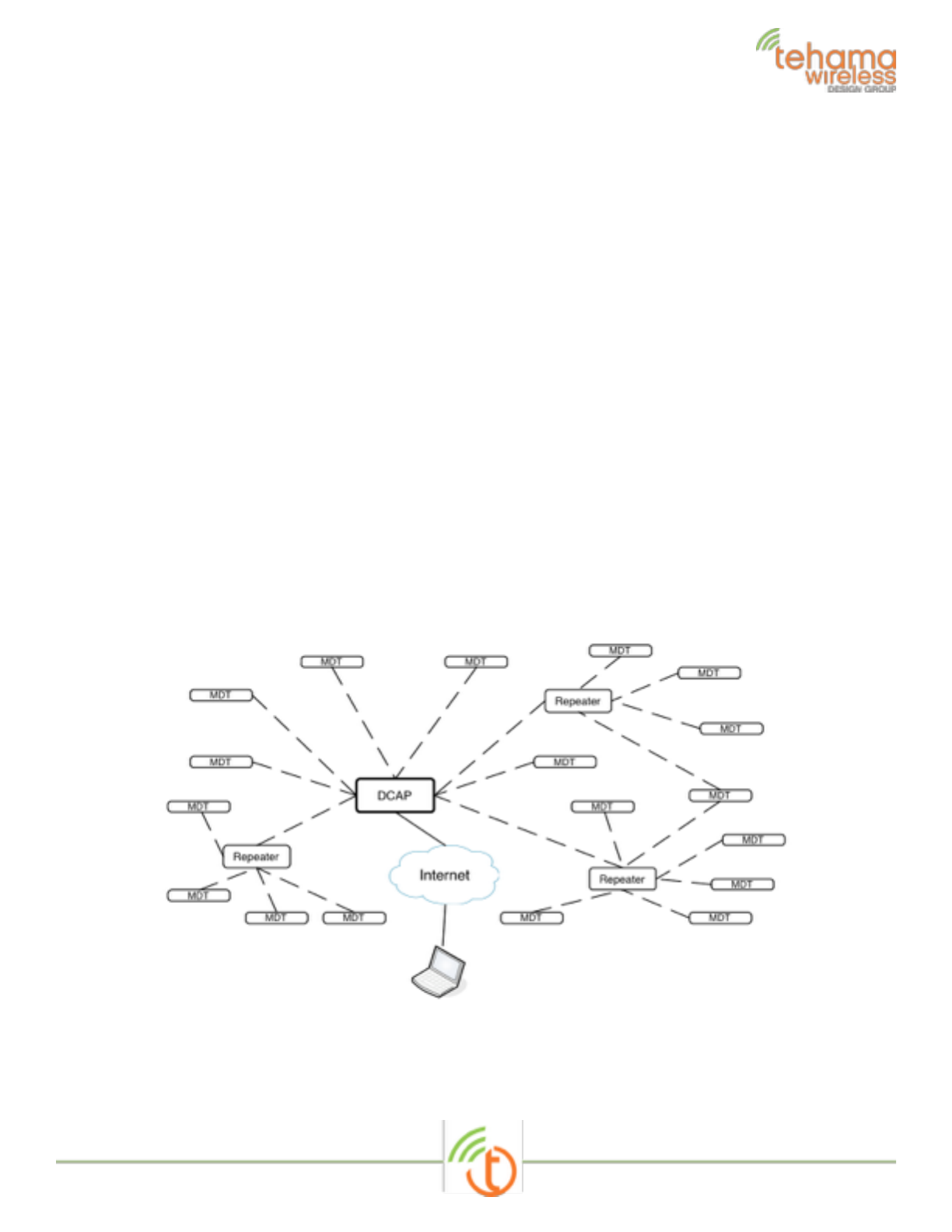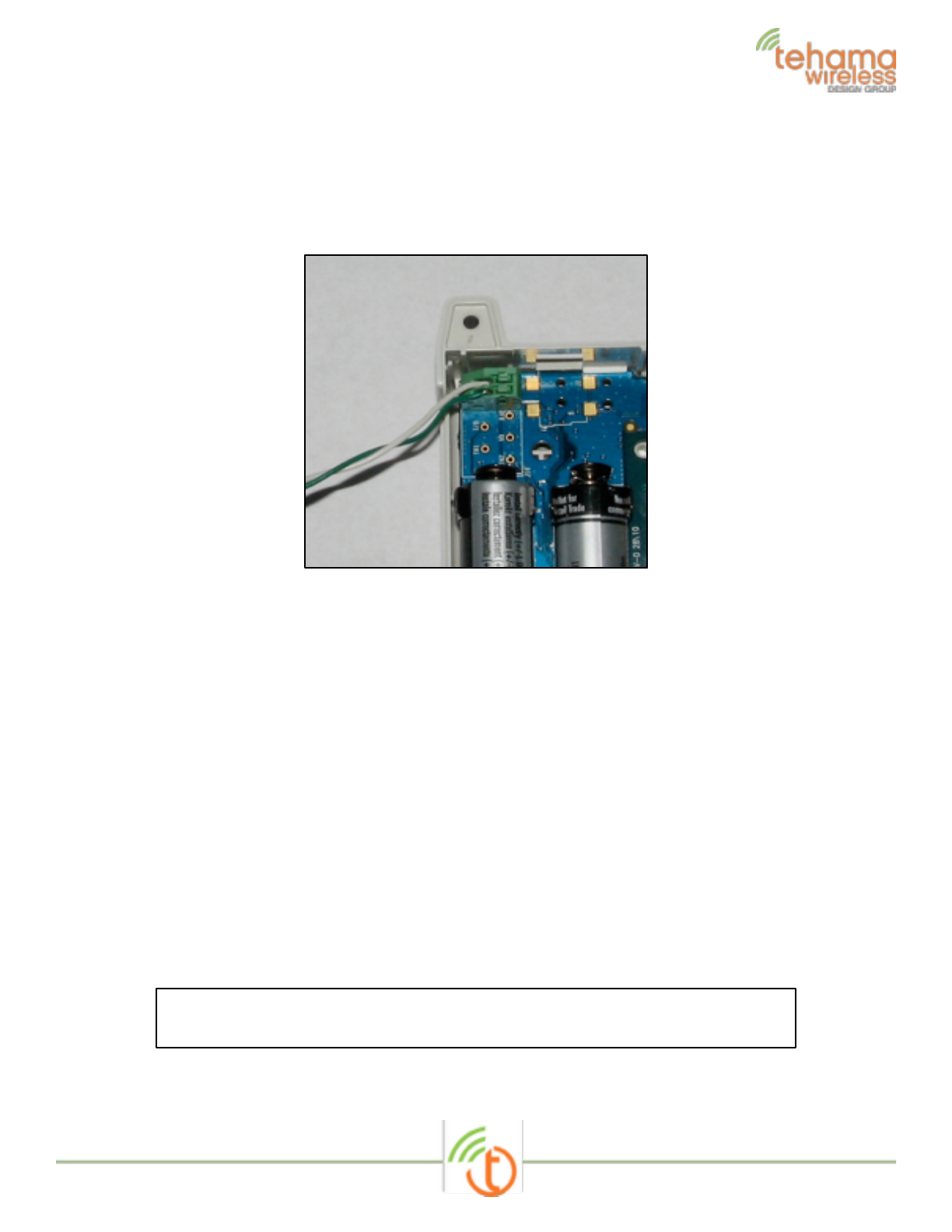Tehama Wireless Design Group TW-221R Diversity Repeater User Manual Tehama Installation Guide pages
Tehama Wireless Design Group Inc. Diversity Repeater Tehama Installation Guide pages
Installation Guide

Tehama System Installation Guide
General Description
The Tehama AMR system consists of three device types to remotely monitor various
environmental and utility readings and provide the data to a central database or PC for formal
presentation and reporting. Metering Data Transceiver (MDT) devices will be placed in all
locations requiring local monitoring of data. The MDT devices will transmit time stamped data
to the DCAP device, which receives the data and stores it in a Database. The database
information is available over Ethernet on the local LAN or the Internet. For MDTs that are out
of range from the DCAP, Repeater devices are added in appropriate locations to relay the data
between MDTs and the DCAP
The system operates in the 915Mhz ISM bands using off-the-shelf FSK RFIC radios. The system
operates as a Frequency Hopper over 60 narrow band frequency channels, incorporating a
bidirectional communication link with Acknowledge (ACK) messages to ensure all data reaches
the DCAP. The MDTs are battery operated, bursting data packets at pre-programmed times
then shutting down to conserve battery life, estimated to exceed 5 years. The DCAP and
Repeater units are line powered.
With an typical MDT transmission rate of four per hour for time of use applications, a single
DCAP can accommodate up to 1000 MDTs. There is no limit to the number of repeaters,
though an average installation may require one Repeater for every 20-30 MDT/MDTs.
Figure 1: Typical System
Tehama Installation Guide ! of ! 1 6

A system consists of two or three types of hardware, and a software program:
•One DCAP Unit or Access Point
•A variable number of MDT units, each with 2 AA batteries
•A variable number of Repeater units (optional, depending on size of installation) with
external DC power supply.
•Tehama Configuration Utility (CIT) running on a PC
Warning
Tehama Configuration & Installation Tool (CIT)
You should have received a copy of the Tehama Configuration and Installation Tool (CIT)
software. If not, please contact support@tehamawireless.com and request the link. The CIT
runs on a Windows based PC. More detailed information can be found in the Tehama CIT User
Manual or the Tehama QuickStart Guide.
The tool can be run on the PC either prior to or during a site installation, or when new MDTs are
added to a system. The tool is used to add configuration data to the database. Examples of
configuration data include the name, type, and location of equipment an MDT is connected to,
and alarm trigger settings for the different MDTs.
Data Collecting Access Point (DCAP) Setup
This step configures the Internet settings for the DCAP and lets you set unique passwords for
remote access.
•Power up the DCAP with the supplied power adaptor.
•Screw in the AP antenna that came with the unit.
•Attach the supplied USB cable to your computer and to the AP. If this is the first time
attaching tan AP, Windows may respond with a “found new hardware” message. Follow the
steps to let Windows download the driver software.
•Attach the AP to your local LAN with the supplied Ethernet cable.
•Launch the CIT tool on the PC
•Go to the Config menu and select DCAP. The Serial Port field should be automatically
populated with the correct COM port
•Click on the Get button to see the current settings
•DCHP (Dynamic IP Address) is the default. If you want a static IP, select static and fill out
the extra fields.
Tehama Installation Guide ! of ! 2 6
NOTE: THE MANUFACTURER IS NOT RESPONSIBLE FOR ANY RADIO OR TV
INTERFERENCE CAUSED BY UNAUTHORIZED MODIFICATIONS TO THIS EQUIPMENT.
SUCH MODIFICATIONS COULD VOID THE USER’S AUTHORITY TO OPERATE THE
EQUIPMENT

•Set the MySQL database passwords for both users and click “Set”. Clicking on the “Default
Vals” button will fill the fields with the factory default passwords. This is provided as a
convenience if password security is not an issue (for example in an evaluation system).
•Click on the “Create a Site Entry” button to auto-fill a Site entry with the information from
this panel.
•Unplug the USB cable. It is not needed again unless you need to change the IP address or
the database passwords at a future time.
MDT Configuration
All MDT come from the factory with a default factory-set configuration. The following
parameters can be custom configured at the factory only; they cannot be changed by the user.
There are no parameters which can be configured on the DCAP or Receiver.
•Monitor Type, defined as the type of meter the MDT is attached to for readings. Our basic
pulse MDT all work with 99% of the meters, but special units can be ordered for Hersey
pulse meters, Encoder meters, etc. Additional data can be factory configured, such as
temperature measurements.
•Transmit Interval, defined as the time between scheduled transmissions of temperature
data. Regular pulse meters transmit once every hour (60 minutes). Our Time of Use units
are configured to transmit four times an hours (15 minutes).
•Measure Interval, defined as the time between scheduled temperature measurements.
This is used in conjunction with Temperature Change (see below) and must be smaller than
the Transmit Interval time. A value of 0 for this parameter will disable measurements in
between the Transmit Interval. The units for this parameter are in seconds, with default set
to 0.
•Temperature Change, defined as a percentage change in the Thermistor resistance value
(i.e. temperature) detected by the MDT. A Delta Temp alarm will be generated within the
PC Software if a MDT reading taken at a Measure Interval is more than Temperature Change
percent from the prior Transmit Interval value. The units for this parameter are Percent
(%), with the default value set to 0.
Tehama Installation Guide ! of ! 3 6
THIS DEVICE COMPLIES WITH PART 15 OF THE FCC RULES. OPERATION IS
SUBJECT TO THE FOLLOWING TWO CONDITIONS:
(1) THIS DEVICE MAY NOT CAUSE HARMFUL INTERFERENCE, AND
(2) THIS DEVICE MUST ACCEPT ANY INTERFERENCE RECEIVED, INCLUDING
INTERFERENCE THAT MAY CAUSE UNDESIRED OPERATION.

Turning on the Unit (for MDT and Repeater)
MDT and Repeater devices come from the factory in a powered off state. They can be powered
on using a hidden button under the label.
The yellow circle in the photo below shows where the hidden button is located on the
enclosure. It may take a few times to get the feel of the button, but an LED in the clear
window to the right gives you feedback when the button is pushed.
• To turn a unit ON, press and hold the button until the LED starts to blink (about four
seconds).
• After about 30 seconds the LED flash frequency should change from slow to fast. After
another 30 seconds or so, the LED will stay solid for 10 seconds than go out. The long flash
indicates the unit is communicating with the network.
• To turn a unit OFF, press and hold the button again unit the LED flashes twice (about four
seconds).
LED Flash Indication States during power-up:
Slow flash: The unit is listening for a DCAP and/or a WAM network
Rapid Flash: The unit has heard a DCAP and/or a WAM network beacon and is in process
of joining the system.
Solid Flash: The unit has confirmation that it has successfully joined the WAM network.
LED Flash indication States when button is momentarily pressed:
Single Flash: The unit is in a light sleep mode. It will wake up every 10 minutes to listen
for a WAM network. This mode can prematurely drain the batteries if no
WAM network is nearby.
Double Flash: The unit is OFF
Long on: The unit is part of a WAM network. Stays on for about 10 seconds.
Tehama Installation Guide ! of ! 4 6

MDT to Meter wiring
Wiring an MDT to a pulse output meter is quite simple. From the factory the MDT’s can
optionally come pre-wired with about 24 inches of pre-stripped wire. If a longer length is
required, it is easy to switch wires. Polarity of the wires does not matter since the MDT simply
detects the open/close nature of the isolated pulse output switch from the utility meter.
To add or switch pulse input wires:
• Unscrew single screw to open the case
• Locate the green connector shown in the image above. Push down on the little button with
a flat blade screw driver to release the old wire.
• Repeat to insert a new 3/8 inch stripped wire into the opening. Up to a 22 gauge wire,
stranded or un-stranded, can be used. It is convenient to angle the wire about 30 degrees
from vertical when inserting them into the connector.
• Release the button to secure the wire.
• Route the wire pair through the hole in the enclosure. Wrapping the wire around one
battery can provide some strain relief. Allow for an extra five inches in wire length if doing
this.
• Close the case and secure with the screw.
Device Placement
Tehama Installation Guide ! of ! 5 6
Warning: All radio devices should be placed at least 8 inches (20 cm) away from
people in order to minimize RF exposure.

With the DCAP Unit powered up and the CIT tool running, the repeater backbone can be
placed. Start with units closer to the DCAP/AP, and use the LED feedback indication to verify
the range is acceptable. At first just the minimum numbers of repeaters can be placed, with
additional repeaters added to fill in holes after MDT placement.
Once the initial Repeater placement is complete, the MDT placement phase begins. Again the
LED feedback can be used to verify that MDTs are communicating with the network. Additional
repeaters can be placed in areas will minimal coverage. The CIT software can also be used in
the placement phase to provide more detailed information such as Link Quality and Signal
Strength reading generated by MDT and Repeaters. In particularly dense sites such as in
modern Hospitals, a Sniffer unit may be used to monitor local radio traffic. A Sniffer is just a
receiving unit that displays any received message on a Laptop over a USB cable.
Guidelines
MDTs can be mounted in a number of ways by utilizing velcro strips, tie-wraps, or screws. Units
may be mounted to the wall or other *NON METAL* flat surfaces with screws or velcro, and
strapped to pipes or posts by placing tie-wraps through the two slots on the flanged case.
Units should not be placed directly on the metal surface. Mounting on a metal surface will
significantly affect the radio performance of the device.
Notes
!
Contact us:
Tehama Wireless !
2607 7th Street, Suite G
Berkeley, CA 94710
415.495.7344
info@TehamaWireless.com ©2015 Tehama Wireless Design Group
www.TehamaWireless.com Rev.1504
Tehama Installation Guide ! of ! 6 6